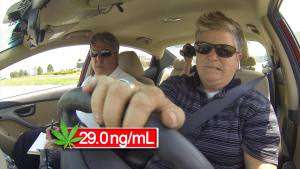Denver TV Station Finds Three Pot Smokers Who Don't Drive So Well When They're Stoned

In a recent experiment by KCNC, the CBS station in Denver, three daily cannabis consumers performed poorly on a driving course after smoking pot and achieving THC blood levels ranging from more than twice to more than five times Colorado's new presumptive legal limit of five nanograms per milliliter. The results contrast with those of experiments by Denver's Fox station and by the CBS affiliate in Seattle, in which marijuana users performed competently (on a simulator and a driving course, respectively) at THC levels far above five nanograms. The differences highlight the wide interpersonal variability in marijuana's impact on driving ability, which is a good reason to be wary of any attempt to equate a particular THC level with impairment.
Unlike its sister station in Seattle, KCNC, a.k.a. CBS4, did not have a police drug recognition expert observe the subjects as they navigated the course, relying on the judgment of the driving instructor who accompanied them, supplemented by images captured by 10 cameras on and near the car. Although the instructor never had to take the wheel or use his brake, he said all three volunteers seemed impaired after smoking marijuana, which they did repeatedly. CBS4's description is rather hazy on the question of how impaired the drivers were and at which THC levels.
Lauren, a 25-year-old who "describes herself as a heavy marijuana user," arrived with a THC level of 11.2 nanograms, more than twice the legal limit, "even after refraining from smoking for 10 hours." (She had, however, consumed marijuana edibles and hash the night before.) Lauren's first smoke raised her THC level to 18.8 nanograms. Here is CBS4's description of her performance:
Early on Lauren had steering problems. Like the others, Lauren redid the course three times after smoking each time. Stolberg [the instructor] noted she had problems with speed and going beyond stop signs.
Although the impact of residual THC is a crucial issue in the debate about how to define driving under the influence of a drug (DUID), CBS4 does not say how Lauren did in her initial runs through the course, before her first puff. If she completed the course satisfactorily at that point, when her THC level was 11.2 nanograms, that would be evidence against the five-nanogram cutoff. And if she was screwing up from the very beginning, that raises the question of whether her performance got worse after she consumed cannabis or remained about the same.
Ty, a 50-year-old who "describes herself as a medium to heavy smoker," arrived with a THC level of 1.4 nanograms and hit 12.1 after her first smoke. At that point, says CBS4, she "had trouble maintaining the speed limit and hit several cones." According to the instructor, "She did worse than the first time. She's missing entire elements of the course."
Chris, a 28-year-old who "smokes a moderate amount every day for pain relief," had an initial THC level of 1.8 nanograms, which rose to 26.5 after his first smoke. At that level, says CBS4, "his performance is described as more conservative with more jerky steering, but he only hit a small number of cones." The station adds that "his speed increased as his THC levels went up throughout the tests and he struck a few more cones." Although "he thinks he is doing just fine," says the instructor, "I think he's driving like he's impaired." It's not clear at what point the instructor said that. At 26.5 nanograms, following Chris's initial smoke, or later, when his THC level climbed to nearly 40? If Chris drove OK at 26.5 nanograms, that hardly reinforces the case for assuming drivers are impaired at five.
More generally, note what this experiment did not test: whether pot smokers are unsafe drivers at or near five nanograms. Although Colorado's new DUID law presumes they are, all of the volunteers either drove OK at levels far below that or drove poorly at levels far above. One can imagine better designed, more rigorous studies with larger samples that would help settle the question of whether five nanograms or any other specific THC level makes sense as a DUID definition. The question is why Colorado's legislature did not wait for such data rather than rushing to enact an unvalidated standard.
In related news, A.P. reports that a man who "uses marijuana for religious reasons" hopes to overturn Colorado's new DUID standard through a federal lawsuit, presumably under the Religious Freedom Restoration Act. His chances do not look good, since federal courts have not looked kindly on claims involving sacramental use of marijuana, and in this case there is an added public safety argument that they probably will accept at face value.
Meanwhile, Nevada legislators are considering adding a medical exception to that state's DUID law. Nevada allows medical use of cannabis yet defines DUID as driving with two or more nanograms of "marijuana" per milliliter of blood. Unlike Colorado, Nevada does not allow defendants to present evidence that they were not actually impaired. In practice, the combination of the low ceiling and the per se rule (under which conviction is automatic for people who test at or above the cutoff) means that many, if not most, regular users can never legally drive. That policy makes no sense if the aim is to protect the public from impaired drivers. Yet the fact that someone consumes cannabis for medical rather than religious or recreational purposes is irrelevant to the question of whether he can safely operate a motor vehicle (except indirectly, since medical users may be more likely to consume cannabis frequently, which can affect their ability to drive at a given THC level because they develop tolerance and learn how to adapt to marijuana's effects). If Nevada changes its DUID law (as it should), the same standard should still apply to all drivers.
[Thanks to Richard Cowan for the A.P. links.]
